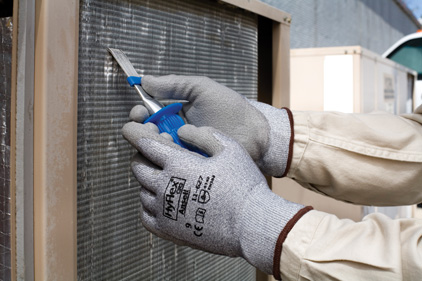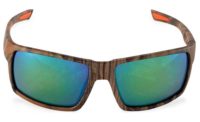The new alternative
Seamless coated knit gloves are extremely versatile and have revolutionized the fit and feel of hand protection. Knitted from various base materials such as cotton, synthetic yarns (polyester and nylon), and high performance yarns (Kevlar® and Dyneema®), seamless coated gloves are less labor intensive to produce. Use of various synthetic coatings such as latex, nitrile, foam nitrile, and polyurethane can also enhance grip characteristics and provide improved durability and wear life.
Dexterity and ergonomics are crucial in making a glove choice. Gloves that are tight may restrict movement and can increase stress to the hands. Gloves that are too bulky will cause workers to exert more force in handling objects, which can result in unnecessary strain.
A seamless coated knit glove offers comfort — allowing hands to breathe — and conforms to the hand for a better fit, hence the saying “it fits like a glove.” Seamless coated gloves also provide workers with enhanced grip and durability. Some thinner 13- and 15-gauge styles can also provide workers with enhanced sense of touch and the ability to handle smaller objects such as nuts, bolts or electronic components.
These knitted alternatives have a better fit and provide greater functionality than leather. With these gloves, workers are able to perform meticulous tasks while improving safety, increasing productivity and providing long-term cost savings to the employer by reducing claims for hand injuries that are often preventable.
Assessment of cut resistance
More and more attention is being given to cut protection, as it is represents one of the leading incidents for hand injuries. Cut resistance is a function of a glove’s material composition and weight. Cut protection can be influenced by the strength, hardness (dulling effect), lubricity (slickness) and/or roll of the yarns used in glove construction. Use of high-performance materials such as Kevlar® or Dyneema® are being incorporated into glove specifications as a means of improving cut resistance.
Both materials provide a clear performance advantage, offering five to ten times more cut resistance than leather and are 15 times stronger than steel on a weight-for-weight basis. These materials are often blended or engineered with stainless steel or fiberglass fibers for vastly improved cut protection levels and are often available with various coatings. Durability and cut-resistance must be taken into account as critical factors when choosing a workplace glove.
When selecting a cut-resistant glove, it is helpful to compare data on cut levels. Globally, there are two different performance standards for cut resistance: the European Standard EN388 and the American National Standard ASTM1790-05. Cut-level results for these two standards are based on different testing methods and therefore cannot be correlated. When referring to a cut level, know which standard is being referenced in order to set the right expectations for performance and specifications. Most cut-resistant gloves are tested scrupulously under both standards.
Inherent cost-savings
Price, of course, also plays a role in glove choice. It isn’t hard to see that seamless coated knit gloves produce a substantial long-term savings over leather. Labor costs are greatly reduced in the production of seamless knitted styles, reducing one key variable in the final cost structure. Seamless coated knit gloves can last twice as long as cotton and remarkably, three times as long as leather. The impact of preventable injury on employee productivity, as well as corporate health insurance costs, is substantial. Each disabling hand injury can cost as much as $26,000. Additionally, OSHA reports that hand injuries are the second leading cause of preventable work-related injury.
Evolution of gloves
Leather was, for many years, considered to be the standard form of hand protection used for medium to heavy-duty jobs. Leather gloves afford good mechanical properties for abrasion and puncture resistance. But as the years have passed, we have been taught that leather possesses qualities similar to human skin — meaning that leather gloves do not provide wearers with the best form of cut protection.
Poor-fitting hand protection can negatively impact productivity and efficiency rates of workers by inhibiting wearers from working to their greatest potential. This often results in lost revenue and lapsed delivery of results. Poor fit or uncomfortable gloves have also been noted by workers as reasons gloves are removed to complete a task, which ultimately leads to greater risk for hand injuries. Proper fit, enhanced dexterity and tactile sensitivity make seamless knit gloves more comfortable and functional reducing fatigue and chances of workers removing their gloves to perform a task.



